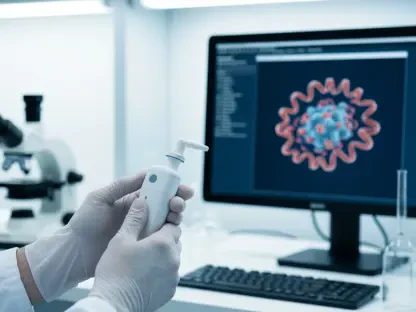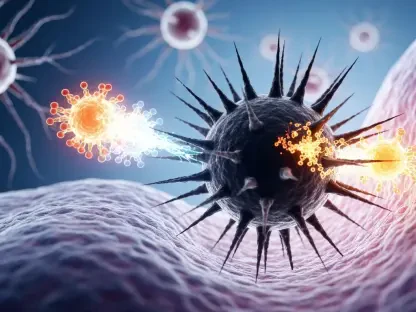Spinal Muscular Atrophy (SMA), a rare genetic disorder that causes progressive muscle weakness and significant life challenges, has long been a focus of medical research seeking transformative solutions for affected individuals across all ages. A pivotal moment in this journey arrived on November 17 of this year with the European Medicines Agency’s Committee for Medicinal Products for Human Use (CHMP) issuing a positive opinion on a higher-dose regimen of nusinersen, commercially known as Spinraza, developed by Biogen in collaboration with Ionis Pharmaceuticals. This development isn’t merely a clinical update but a potential turning point for SMA management, promising enhanced outcomes for patients globally. As the SMA community grapples with persistent gaps in care despite past advancements, this new dosing option sparks hope and raises critical questions about its implementation and impact. This article delves into the clinical evidence, regulatory landscape, unmet needs, and challenges surrounding this innovative approach, painting a comprehensive picture of what lies ahead for SMA treatment.
Unpacking the Clinical Breakthrough
The backbone of the high-dose nusinersen regimen’s promise rests on the DEVOTE study, a robust Phase II/III clinical trial that meticulously evaluated its efficacy across diverse patient groups. This study included both treatment-naïve infants and individuals previously on the standard 12 mg dose, offering a broad perspective on the regimen’s potential. The findings are compelling: infants who had not previously received treatment exhibited statistically significant improvements in motor function when compared to a historical sham group, alongside a marked reduction in the risk of death or the need for permanent ventilation. Such results underscore the possibility that a higher dose could set a new benchmark for early intervention in SMA, particularly for the most common form, 5q SMA, where motor decline can be devastatingly rapid if not addressed effectively.
Beyond initial outcomes, the DEVOTE study also shed light on the benefits for patients transitioning from the standard dose to the higher regimen. Within approximately 302 days of starting the new dosing, these individuals demonstrated noticeable gains in motor skills, a critical indicator of quality of life for those with SMA. This suggests that even patients with prior treatment history could experience meaningful progress, challenging previous assumptions about the limits of therapeutic impact after initial interventions. The clinical evidence not only validates the higher dose as a viable option but also signals a shift toward more aggressive and tailored strategies in managing this complex disorder, potentially altering the trajectory of care for countless individuals.
Navigating the Global Regulatory Landscape
The implications of the high-dose nusinersen regimen extend far beyond clinical settings, as regulatory bodies worldwide begin to weigh in on its adoption. With the standard dose already approved in over 71 countries, the higher-dose option has recently gained approval in Japan, setting a precedent for other regions. Decisions are pending in key markets, with the European Commission expected to finalize its stance by January 2026 and the United States anticipated to follow by April 2026. This global momentum hints at a future where SMA treatment protocols could undergo significant revision, aligning with emerging evidence of enhanced efficacy. However, the harmonization of approvals across diverse healthcare systems remains a complex puzzle, requiring coordinated efforts to ensure equitable access for patients regardless of geographic location.
Another layer to this regulatory narrative is the logistical challenge posed by nusinersen’s intrathecal administration, a method requiring specialized training and infrastructure. As healthcare systems prepare for potential widespread adoption of the higher dose, questions arise about resource allocation and the capacity to train professionals for safe delivery. Disparities in healthcare access could complicate implementation, particularly in regions with limited expertise or funding for rare disease care. The regulatory progress, while promising, thus serves as a call to action for stakeholders to address these practical barriers, ensuring that the benefits of this treatment innovation are not confined to a select few but reach the broader SMA community in need of advanced therapeutic options.
Addressing Persistent Gaps in SMA Care
Despite remarkable strides in SMA therapies over recent years, the community continues to face unmet needs that demand innovative solutions, a sentiment echoed by industry leaders like Priya Singhal, MD, MPH, from Biogen. The higher-dose nusinersen regimen emerges as a response to this urgency, positioned to potentially bridge gaps where current treatments fall short in improving patient outcomes. The drive for therapies that can further enhance motor function and overall quality of life remains a priority, as many individuals with SMA still experience significant limitations despite available options. This new dosing strategy represents not just an incremental change but a meaningful step toward redefining what is possible in managing a condition that profoundly impacts daily life for patients and their families.
Expert voices add weight to this perspective, with figures like Eugenio Mercuri, MD, PhD, a respected name in pediatric neurology, expressing confidence in the tangible benefits of the high-dose regimen based on clinical results and patient feedback. This endorsement reflects a broader trend in rare disease treatment toward personalized approaches, where dosing can be optimized to match individual patient profiles and disease severity. The focus on tailoring therapy highlights a shift in how SMA care is conceptualized, moving away from one-size-fits-all models to strategies that prioritize specific needs and long-term sustainability. As this regimen gains traction, it could inspire similar innovations across other rare disorders, amplifying the impact of personalized medicine in challenging therapeutic landscapes.
Balancing Innovation with Practical Challenges
While the high-dose nusinersen regimen offers a beacon of hope, it also brings to light the complexities of integrating such advancements into real-world healthcare settings. The safety profile of this higher dose aligns with what is already understood about nusinersen and the typical clinical events associated with SMA populations, providing some reassurance to clinicians and patients alike. However, the ongoing phases of the DEVOTE study are vital for uncovering any long-term effects or rare adverse reactions that may not surface in shorter trial periods. This need for extended surveillance emphasizes that innovation must be paired with caution, ensuring that enthusiasm for improved outcomes does not overshadow the importance of thorough risk assessment in a population already vulnerable to health complications.
Implementation challenges further complicate the picture, as the specialized nature of intrathecal administration demands a level of expertise and resources not universally available across healthcare systems. Continuous monitoring and clinician guidance become non-negotiable elements in safely rolling out this regimen, placing additional responsibilities on medical professionals who must balance patient care with evolving treatment protocols. As the SMA community anticipates broader access to this higher dose, the focus shifts to building capacity within healthcare infrastructures to support its delivery. Addressing these practical hurdles will be crucial to translating clinical promise into sustained, safe benefits for patients, ensuring that the potential of this treatment is fully realized without unintended setbacks.
Looking Ahead to Transformative SMA Care
Reflecting on the journey of the high-dose nusinersen regimen, it’s evident that this development marks a significant chapter in the ongoing battle against SMA. The compelling clinical evidence from the DEVOTE study, coupled with global regulatory progress, paints a picture of optimism for better patient outcomes. At the same time, the persistent unmet needs and practical challenges of implementation are acknowledged as critical factors that shape the rollout of this innovative dosing strategy. Each step forward in this process is a testament to the dedication of researchers, clinicians, and advocates who push for advancements in rare disease care.
Moving into the future, the emphasis must rest on actionable solutions to ensure that the benefits of high-dose nusinersen reach every corner of the SMA community. Stakeholders should prioritize training programs for healthcare providers to master intrathecal administration, while international collaboration could accelerate equitable access across regions. Additionally, sustained investment in long-term studies will be essential to confirm the durability of therapeutic gains and address any emerging safety concerns. By focusing on these next steps, the legacy of this treatment advancement can evolve into a cornerstone of personalized, effective SMA management, offering lasting improvements in quality of life.









